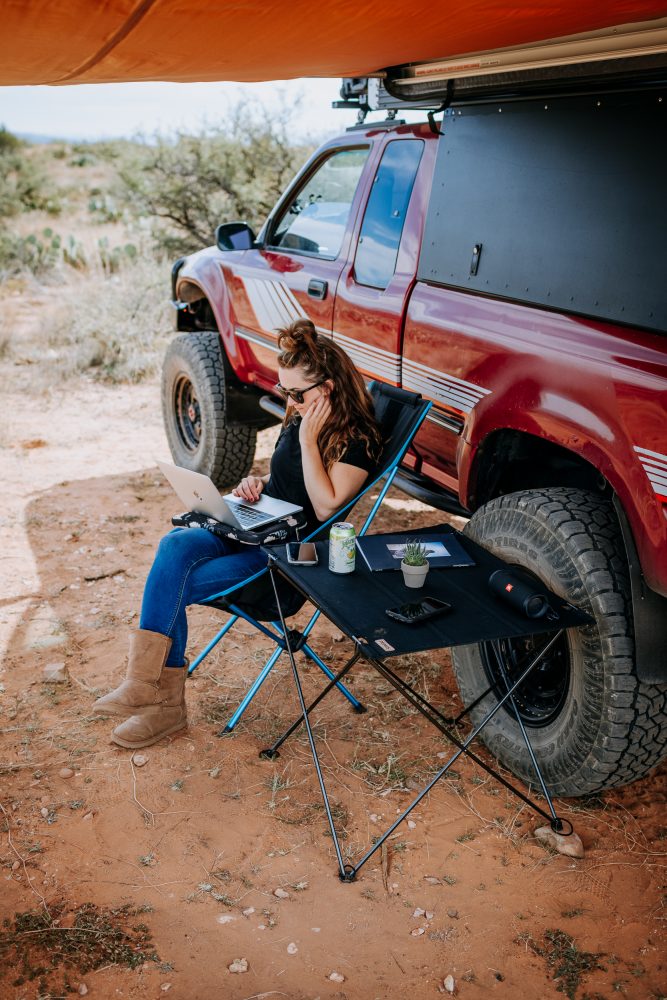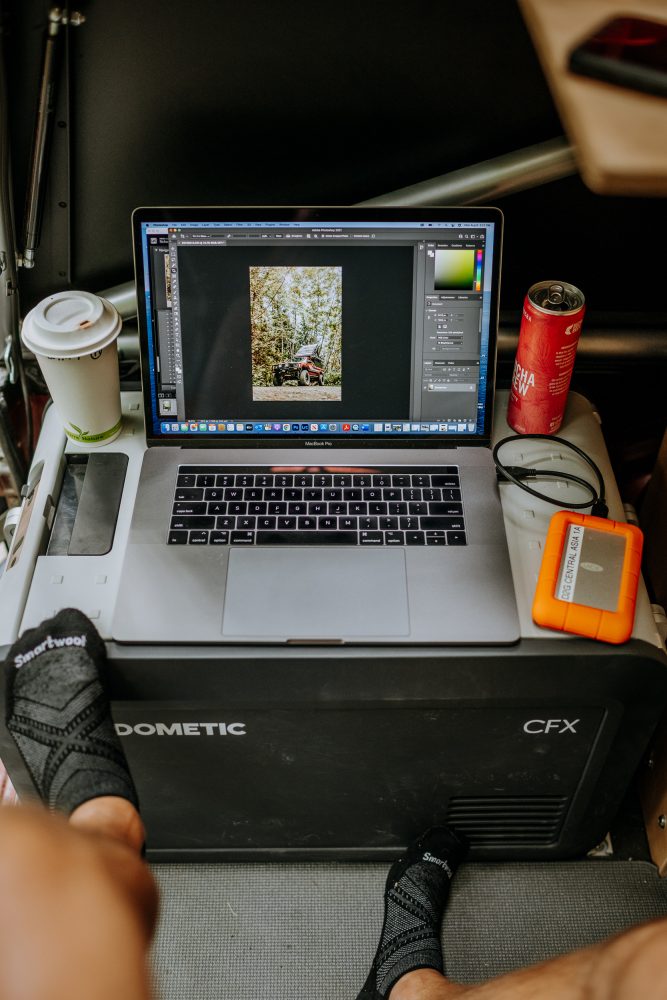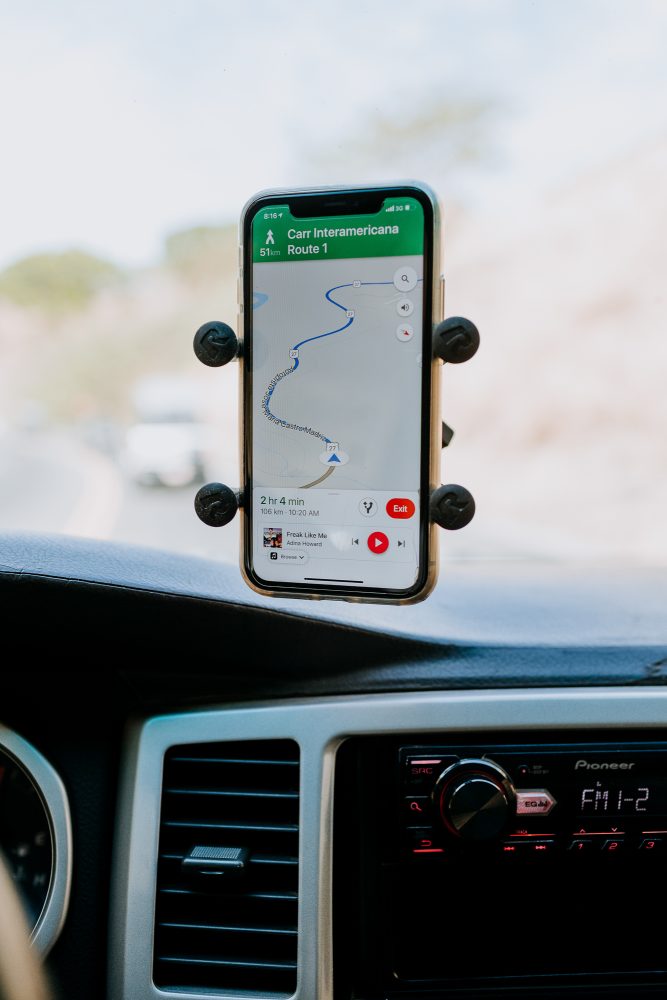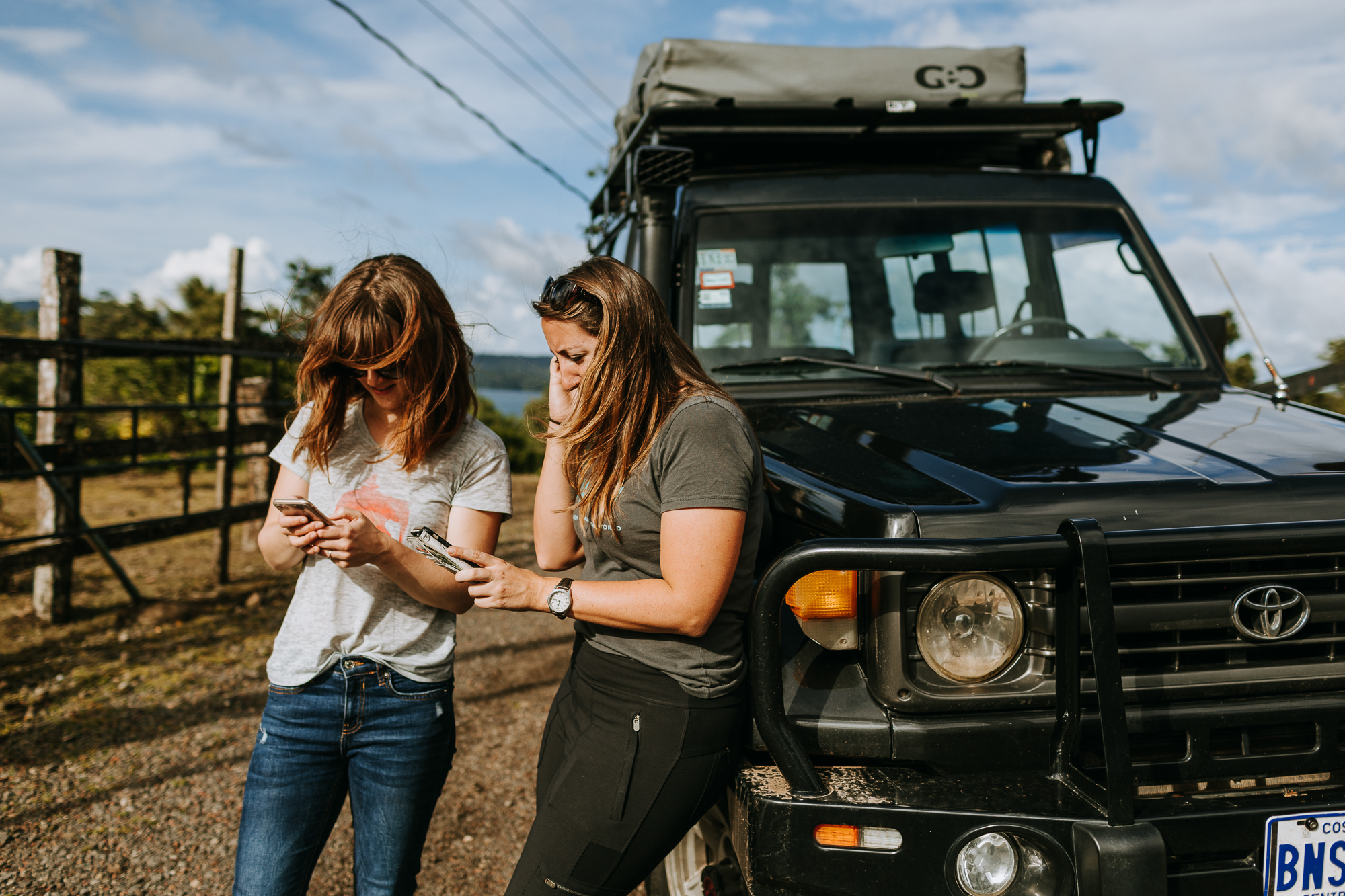Photography by Richard Giordano
I remember blissfully roaming through the Americas, connecting to WiFi at my leisure, refusing to purchase local SIM cards, and providing the occasional update to our fans back home (my parents) via an inReach communication device. I used public WiFi for the basics: emails, updating our travel blog, and the occasional video call with family members in Canada.
Now, the ability to connect to the World Wide Web is essential to my role at Expedition Portal and Overland Journal and necessitates a commitment to being online regularly. I share this personal experience because it highlights one of the most important lessons regarding staying connected while overlanding—it’s unique to each of us and our needs.
Whether you use a personal mobile hotspot, cell phone signal booster, or Google Fi depends on various factors, including how much time you spend streaming YouTube videos, if you are working from the road full-time, or whether you choose to travel internationally. The good news is there are a variety of options out there, with more coming in the future. With this in mind, here’s our definitive guide to finding the internet while overlanding.
Cellular Internet Data Plan
Approximately 83.96 percent of the world’s population owns a smartphone, so it’s easier than ever to connect to the internet via a personal cellular internet data plan. This is especially so for domestic travelers. Cellular data plans are simple, internet speed can be faster than many WiFi connections, and some plans provide roaming flexibility for those traveling out of the country for short periods.
Depending upon your carrier, international data roaming can be costly for longer-term trips, occasionally resulting in “bill shock” if you don’t investigate before departure. Obviously, plans vary significantly from country to country. For example, roaming fees with the US-based Verizon Travelpass cost $5 per day in Canada and Mexico and $10 per day in other countries. At the same time, my Canadian phone plan with Bell Mobility provides free roaming in the US but charges $15 per day in Mexico and abroad. In some cases, it makes more sense to purchase a local SIM card.
Another attractive option for US residents is Google Fi. This cell phone carrier switches between multiple mobile networks from T-Mobile and US Cellular and secure WiFi connections. Its network also extends to 200+ countries and territories, so international coverage is available at no extra cost with Google Fi’s Unlimited and Flexible plans. However, a word of warning: Google Fi recommends using a local carrier if staying abroad for an “extended period of time” and is “not intended for extended international use.” Doing so could result in termination of the service.
If you are departing on an international trip, investigate your current plan and understand how much data you require. Do you need high-cap data options or an “unlimited” plan? Is it best to use two or more cellular carriers for redundancy? Does your plan work for country-wide travel? What about internationally? Will you use your smartphone as a mobile hotspot? Consider video streaming—watching Netflix or YouTube videos can quickly eat up data, and many carriers implement restrictions.


Personal Mobile hotspot
Mobile hotspots take a cellular connection and convert it into a WiFi signal, connecting with laptops, tablets, and other devices. Most modern smartphones have a built-in hotspot feature that allows you to connect multiple devices to your network. I’ve done everything from attending editorial meetings to copyediting to uploading articles on Expedition Portal from my laptop, using my cell phone as a mobile hotspot while on the road in Canada, the US, Mexico, Costa Rica, Saudi Arabia (they have fantastic 4G throughout the country), and beyond. The pros include flexibility, ease of use, and the ability for multiple people to connect to one hotspot.
Mobile hotspots are a great but imperfect solution. Depending on your carrier or device, access can come with additional costs or speed caps. The hotspot’s speed and longevity will depend on your data plan, how many gigabytes you have, and will drop in performance with each connected device. My carrier imposes a speed cap after using 500 megabytes while roaming, another reason to go with a local SIM card while overlanding internationally. Hotspots also rip through battery life quickly, so be mindful about keeping devices charged.


Mobile Hotspot Devices
To address the disadvantages of a mobile hotspot, folks working from the road often complement their setup with a mobile hotspot device. Hotspots are typically supported by cellular networks and perform faster, save phone batteries from quick depletion (some offer over 12 hours of continuous use), and often provide better security than a mobile hotspot or public WiFi connection. Users must purchase the hardware, which also requires its own cellular plan.
Most hotspots are equipped with one or more external antenna ports to facilitate an external antenna. Adding an external antenna, also known as MIMO (multiple-input, multiple-output) technology, to a hotspot device can also help boost a cell signal. These antennas are reputed to outperform cell signal boosters for a fraction of the price.
Former Expedition Portal Senior Editor Chris Cordes shared his findings with the Verizon, Sprint, and ATT hotspots, the Skyroam Solis 4G LTE hotspot, and the NetGear MIMO antenna in The Best Backcountry, Travel, and Overland Communication Devices article here.
The Best Backcountry, Travel, and Overland Communication Devices
Cell Signal Boosters
Cell signal boosters act as enhancers, boosting weak signals for use by cell phones, smartphones, tablets, hotspots, and other cellular-connected devices. They have the ability to enhance—not to create. What I mean by that is that they amplify an existing signal. You need cell reception for the booster to work its magic.
Boosters are composed of an external antenna, a signal booster, and an internal antenna. The external antenna communicates back and forth with the closest cell towers, while the signal booster receives the signal and amplifies it. The interior antenna then distributes the signal for use by cellular devices. Boosters work especially well at amplifying your signal back to a cell tower, which means they are most beneficial for tasks such as uploading high-resolution photos or video and teleconferencing.
Brands such as Cel-Fi, SolidRF, HiBoost, and WeBoost are well-known in the overland community. WeBoost, for example, offers different models for Canada, South America, and Malaysia; any other countries are not compatible with their boosters. If you want to travel internationally, check with the manufacturer to ensure the boosters are compatible with carrier networks outside your home country.
Another con is that cellular boosters are expensive. Prices start around $399 USD and can be upwards of $800 USD. Depending on your WiFi needs, it might be best to start with an external antenna paired with a hotspot device to test the waters.
Read: Field-Tested :: WeBoost Drive 4G-X
Finding Coverage
Whether you are using your cellular internet plan, connecting to a hotspot, or using a cell signal booster, there’s one important thing you need: coverage. While finding that elusive bar of service can feel like the quest for the holy grail, there are resources that can ease the search. Coverage maps are the go-to and can tell you the location of the closest cell phone tower (including 5G towers) or provide color-coded coverage maps indicating the type and signal quality. Yes, you will need service to use the following coverage apps. How meta.
The leading cell phone carriers in North America include coverage maps on their websites, which are to be taken with a grain of salt. Actual coverage may vary depending on your plan, your location, nearby terrain (such as mountains and trees), the presence of buildings, and population density. For example, try completing a successful Google search on your phone while attending the Overland Expo grounds in Flagstaff, Arizona.
Some helpful coverage apps include:
- Open Signal App – Provides statistics on your download and upload speeds and responsiveness, plus independent coverage maps on all major network operators worldwide. Crowd-sourced.
- Coverage? App – Allows users to directly overlay and compare cellular carrier coverage maps, including US and Canadian carriers. No internet required.
- CellMapper App – Users can filter by cellular provider and find cell phone towers near their current location.
Campground apps such as Campendium, freecampsites.net, and iOverlander also contain reviews from users about their coverage experience in the area. Finally, the Gaia GPS app’s cell coverage map layer shows 3G, 4G, and LTE service areas in the US for all major carriers.

SIM Cards for International Overlanders
Depending on which countries you’re traveling through, purchasing a local SIM card upon arrival can be the simplest and most cost-effective way to access the internet. However, the process, cost, and ease (or difficulty) vary wildly per country. Note that inserting a local SIM card renders your home phone number obsolete for the time being, which can be inconvenient, especially if you are working from abroad.
The first task is to determine which company offers the best-prepaid plan for your needs. This will require some online research, connecting with a resident of the country you’re traveling to (if possible), and heading to sites like this one which lists prepaid data providers per country.
Local SIM cards can be purchased from cellular provider kiosks at the airport (if you’re in a pinch), stand-alone shops, shopping malls, or even convenience stores in some countries. Bring your passport with you, as cellular providers often require it to process the paperwork. It is also important to note that your phone must be unlocked to swap SIM cards. Most phones sold by US carriers are locked, which means users need to either figure out how to unlock their phone or pay a visit to their network provider to do so. For Canadians, all phones sold since December 2017 are already unlocked. This applies to citizens of the UK and Singapore as well.
International SIM cards work best for those taking a few short trips per year or if you’re heading through several countries in a hurry (this could be due to transit visas, weather, etc.). Not surprisingly, options and prices vary. Orange Holiday World, OneSim, and Surfroam are examples of international SIM card providers. Read the fine print—data can vary per country.

Connecting to Public WiFi Networks
While heading off the beaten path is the true calling of many overlanders, towns and cities offer their own charms and conveniences, including a solid WiFi connection. Finding WiFi can be straightforward in more populated areas as many restaurants, fast food chains, hotels, fuel stations, retailers, libraries, coffee shops, malls, and communal workspaces offer access to networks. I’ve also connected to excellent WiFi at Overlander camps and campsites throughout the Americas. Public WiFi speeds and quality range from non-functional to stellar.
The Future: Mobile Satellite Internet
The space race has begun for low Earth orbit satellite networks. SpaceX’s Starlink leads the pack, promising to bring fast, affordable broadband internet to those in rural and underserved areas, while Amazon aims to launch its first Project Kuiper satellites in the fourth quarter of 2022. Is it too early to consider Starlink for overlanding? I didn’t have to look far for an answer. Marcus and Julie Tuck of Tucks’ Truck purchased a Starlink system in November 2021 and have documented their experiences with it in North America. “Starlink has been a game-changer for us overlanding North America,” Julie tells me, with “unlimited, high-speed data, particularly in locations where there is no cell coverage. But it has its limitations and is not yet suitable for international overlanding.”
The ability to stay connected in remote places brings many benefits—our offices become mobile, we feel safer in off-grid locations, and we are provided with greater opportunities to keep in touch with family, friends, and other overland travelers. It will be interesting to see how gains in satellite technology affect our future travels. In the meantime, I’ll try to turn off my phone and enjoy the star-filled night skies before the sparkle of thousands of satellites becomes the norm.
Our No Compromise Clause: We carefully screen all contributors to make sure they are independent and impartial. We never have and never will accept advertorial, and we do not allow advertising to influence our product or destination reviews.


